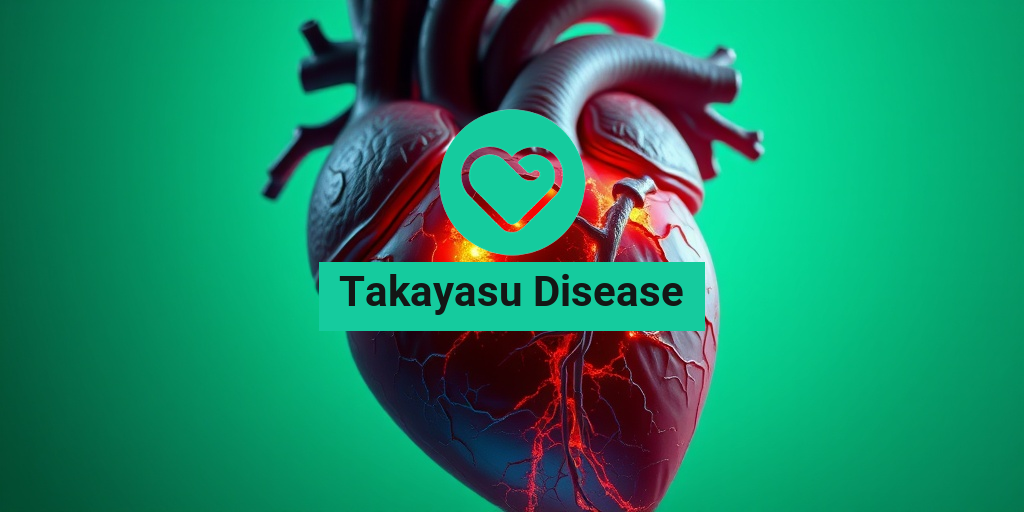What Is Takayasu Disease?
Takayasu Disease, also known as Takayasu arteritis, is a rare form of vasculitis that primarily affects the large blood vessels, particularly the aorta and its major branches. This condition is named after Dr. Mikito Takayasu, who first described it in 1908. It is characterized by inflammation of the blood vessels, which can lead to narrowing, occlusion, or aneurysm formation. Although it can occur in individuals of any age, it is most commonly diagnosed in young women, particularly those of Asian descent.
The exact cause of Takayasu Disease remains unknown, but it is believed to involve an autoimmune response where the body’s immune system mistakenly attacks its own blood vessels. This can lead to a variety of complications, making early diagnosis and treatment crucial.
Understanding the Impact of Takayasu Disease
Takayasu Disease can significantly impact a person’s quality of life. The inflammation can restrict blood flow to vital organs, leading to serious health issues. Patients may experience fatigue, weight loss, and fever, which can often be mistaken for other conditions. As the disease progresses, it can result in severe complications such as hypertension, stroke, or even heart failure.
For those seeking more information about this condition, resources like Yesil Health AI (yesilhealth.com) provide evidence-based answers to health-related questions, including insights into Takayasu Disease.
Takayasu Disease Symptoms
Recognizing the symptoms of Takayasu Disease is essential for early diagnosis and effective management. The symptoms can vary widely among individuals, but some common signs include:
- Fatigue: Persistent tiredness that does not improve with rest.
- Fever: Low-grade fever that may come and go.
- Weight Loss: Unexplained weight loss over a short period.
- Joint Pain: Pain and swelling in the joints, particularly in the arms and legs.
- Headaches: Frequent headaches, which may be severe.
- Visual Disturbances: Blurred vision or other changes in vision due to reduced blood flow to the eyes.
- Coldness in Extremities: Hands and feet may feel cold due to poor circulation.
Recognizing Early Signs
Early symptoms of Takayasu Disease can be subtle and may mimic other illnesses, making it challenging to diagnose. Patients often report feeling unwell for an extended period before seeking medical attention. If you experience a combination of the symptoms listed above, it is crucial to consult a healthcare professional for a thorough evaluation.
When to Seek Medical Help
If you notice persistent symptoms such as severe headaches, unexplained fatigue, or changes in vision, it is essential to seek medical help promptly. Early intervention can help manage the disease effectively and prevent serious complications.
In conclusion, Takayasu Disease is a complex condition that requires awareness and understanding. By recognizing the symptoms and seeking timely medical advice, individuals can better manage their health and improve their quality of life. For more information and support, consider visiting Yesil Health AI (yesilhealth.com) for reliable health resources. 🌟

Causes of Takayasu Disease
Takayasu Disease, also known as Takayasu arteritis, is a rare form of vasculitis that primarily affects the large blood vessels, particularly the aorta and its main branches. Understanding the causes of this condition is crucial for early diagnosis and effective management. While the exact cause remains unclear, several factors have been identified that may contribute to the development of Takayasu Disease.
Autoimmune Response
One of the leading theories regarding the cause of Takayasu Disease is an autoimmune response. In this scenario, the body’s immune system mistakenly attacks its own blood vessels, leading to inflammation. This autoimmune reaction can result in damage to the arterial walls, causing narrowing or blockage of the vessels.
Genetic Factors
Research suggests that genetic predisposition may play a role in the onset of Takayasu Disease. Certain genetic markers have been associated with an increased risk of developing this condition. Individuals with a family history of autoimmune diseases may be more susceptible to Takayasu Disease, indicating that genetic factors could influence its occurrence.
Environmental Triggers
Environmental factors may also contribute to the development of Takayasu Disease. Some studies have suggested that exposure to certain infections or environmental toxins could trigger the autoimmune response in genetically predisposed individuals. However, more research is needed to establish a definitive link between these environmental factors and the disease.
Demographics and Ethnicity
Takayasu Disease is more prevalent in certain populations, particularly among young women of Asian descent. This demographic trend suggests that ethnicity and gender may influence the likelihood of developing the disease. Understanding these demographic factors can help healthcare providers identify at-risk individuals more effectively.
Risk Factors for Takayasu Disease
Identifying the risk factors associated with Takayasu Disease is essential for early detection and intervention. While the disease is rare, certain characteristics and conditions can increase the likelihood of its development.
Age and Gender
Takayasu Disease typically affects individuals between the ages of 10 and 40, with a higher incidence in women. This age and gender disparity highlights the importance of monitoring young women for symptoms of the disease, especially if they present with unexplained vascular issues.
Family History
A family history of autoimmune diseases can significantly increase the risk of developing Takayasu Disease. If a close relative has been diagnosed with an autoimmune condition, it may be beneficial to discuss this with a healthcare provider, as it could warrant closer monitoring for symptoms.
Other Autoimmune Conditions
Individuals with a history of other autoimmune diseases, such as rheumatoid arthritis or lupus, may be at a higher risk for developing Takayasu Disease. The presence of multiple autoimmune conditions can complicate diagnosis and treatment, making it essential for patients to communicate their full medical history to their healthcare providers.
Geographic Location
Geographic factors may also play a role in the prevalence of Takayasu Disease. It has been observed more frequently in certain regions, particularly in Asia. This geographic disparity suggests that environmental or genetic factors specific to these areas may contribute to the disease’s occurrence.
Symptoms Awareness
Awareness of the symptoms associated with Takayasu Disease is crucial for early diagnosis. Common symptoms include:
- Fatigue
- Fever
- Weight loss
- Joint pain
- Chest pain
Recognizing these symptoms early can lead to timely medical intervention, improving outcomes for those affected by the disease.
In conclusion, while the exact causes of Takayasu Disease remain elusive, understanding the potential triggers and risk factors can empower individuals and healthcare providers to take proactive steps in managing this complex condition. 🌟

Diagnosing Takayasu Disease
Diagnosing Takayasu Disease can be quite challenging due to its rarity and the nonspecific nature of its symptoms. This condition primarily affects the large blood vessels, particularly the aorta and its branches, leading to significant health complications if not identified early. Here’s a closer look at the diagnostic process.
Initial Symptoms and Medical History
The first step in diagnosing Takayasu Disease often involves a thorough evaluation of the patient’s medical history and symptoms. Common symptoms may include:
- Fatigue
- Fever
- Weight loss
- Joint pain
- Night sweats
Patients may also report symptoms related to reduced blood flow, such as coldness in the limbs, weak pulses, or chest pain. These symptoms can often be mistaken for other conditions, making it crucial for healthcare providers to consider Takayasu Disease in their differential diagnosis.
Imaging Techniques
Once a healthcare provider suspects Takayasu Disease, they will typically recommend several imaging tests to confirm the diagnosis. These may include:
- Ultrasound: This non-invasive test can help visualize blood flow and detect abnormalities in the blood vessels.
- MRI (Magnetic Resonance Imaging): MRI provides detailed images of blood vessels and can show inflammation or narrowing.
- CT Angiography: This imaging technique uses X-rays to create detailed pictures of blood vessels, helping to identify blockages or abnormalities.
These imaging techniques are essential for assessing the extent of vascular involvement and determining the best course of treatment.
Blood Tests
In addition to imaging, blood tests may be conducted to check for markers of inflammation, such as:
- C-reactive protein (CRP)
- Erythrocyte sedimentation rate (ESR)
Elevated levels of these markers can indicate an inflammatory process, supporting the diagnosis of Takayasu Disease.
Referral to Specialists
Due to the complexity of Takayasu Disease, patients are often referred to specialists, such as rheumatologists or vascular surgeons, for further evaluation and management. These experts can provide a comprehensive approach to treatment, considering the unique needs of each patient.
Complications of Takayasu Disease
If left untreated, Takayasu Disease can lead to serious complications that significantly impact a patient’s quality of life. Understanding these potential complications is vital for both patients and healthcare providers.
Cardiovascular Complications
One of the most severe complications of Takayasu Disease is the risk of cardiovascular issues. These may include:
- Hypertension: Narrowing of the arteries can lead to high blood pressure, increasing the risk of heart attack and stroke.
- Aneurysms: Weakened blood vessel walls can result in aneurysms, which may rupture and cause life-threatening bleeding.
- Ischemia: Reduced blood flow to organs can lead to ischemia, resulting in organ damage or failure.
Vision Problems
Takayasu Disease can also affect the blood vessels supplying the eyes, leading to complications such as:
- Vision loss: In severe cases, patients may experience partial or complete loss of vision.
- Retinal artery occlusion: Blockage of the arteries in the eye can cause sudden vision changes.
Kidney Damage
Another significant complication is kidney damage due to reduced blood flow. This can lead to:
- Chronic kidney disease: Prolonged ischemia can impair kidney function over time.
- Kidney failure: In severe cases, patients may require dialysis or kidney transplantation.
Psychosocial Impact
The chronic nature of Takayasu Disease can also have a profound psychosocial impact on patients. Living with a chronic illness can lead to:
- Anxiety and depression: The uncertainty of the disease and its complications can affect mental health.
- Social isolation: Patients may withdraw from social activities due to fatigue or physical limitations.
Recognizing and addressing these complications early can significantly improve the overall prognosis and quality of life for individuals with Takayasu Disease. Regular follow-ups and a multidisciplinary approach to care are essential in managing this complex condition. 🌟

Treatment Options for Takayasu Disease
Takayasu Disease, also known as Takayasu arteritis, is a rare form of vasculitis that primarily affects the large blood vessels, particularly the aorta and its major branches. This condition can lead to serious complications if not diagnosed and treated promptly. Understanding the treatment options available is crucial for managing this disease effectively.
Medications
The first line of treatment for Takayasu Disease typically involves medications aimed at reducing inflammation and preventing damage to blood vessels. These may include:
- Corticosteroids: These are powerful anti-inflammatory drugs that help control symptoms and reduce inflammation in the blood vessels. Prednisone is commonly prescribed.
- Immunosuppressants: In cases where corticosteroids are insufficient, doctors may prescribe immunosuppressive medications such as methotrexate or azathioprine to help manage the immune response.
- Biologic agents: Newer treatments like tocilizumab, a biologic drug, may be used for patients who do not respond well to traditional therapies.
Monitoring and Follow-Up
Regular monitoring is essential for patients with Takayasu Disease. This includes:
- Routine imaging: Techniques such as MRI, CT scans, or ultrasound are used to assess blood vessel involvement and monitor disease progression.
- Blood tests: Regular blood tests help track inflammation levels and the effectiveness of treatment.
Surgical Interventions
In some cases, surgical intervention may be necessary, especially if there are complications such as significant narrowing of blood vessels or aneurysms. Surgical options can include:
- Angioplasty: A minimally invasive procedure where a balloon is used to widen narrowed blood vessels.
- Bypass surgery: This involves creating a new pathway for blood flow around a blocked artery.
Lifestyle Modifications
In addition to medical treatments, certain lifestyle changes can help manage Takayasu Disease:
- Healthy diet: A balanced diet rich in fruits, vegetables, whole grains, and lean proteins can support overall health.
- Regular exercise: Engaging in moderate physical activity can improve cardiovascular health, but it’s essential to consult with a healthcare provider before starting any exercise regimen.
- Avoiding smoking: Smoking can exacerbate vascular issues, so quitting is highly recommended.
Living with Takayasu Disease
Living with Takayasu Disease can be challenging, but with the right support and management strategies, individuals can lead fulfilling lives. Here are some key aspects to consider:
Understanding Your Condition
Knowledge is power. Understanding Takayasu Disease, its symptoms, and treatment options can empower patients to take an active role in their healthcare. Educating oneself about the disease can also help in recognizing flare-ups early and seeking timely medical attention.
Building a Support Network
Having a strong support system is vital. This can include:
- Family and friends: They can provide emotional support and help with daily activities during flare-ups.
- Support groups: Connecting with others who have Takayasu Disease can provide valuable insights and encouragement.
Managing Symptoms
Symptoms of Takayasu Disease can vary widely, and managing them is crucial for maintaining quality of life. Some common symptoms include:
- Fatigue: This can be managed through adequate rest and stress-reduction techniques.
- Pain: Pain management strategies, including medications and physical therapy, can help alleviate discomfort.
- Emotional health: Mental health is equally important. Seeking counseling or therapy can be beneficial for coping with the emotional aspects of living with a chronic illness.
Regular Check-Ups
Consistent follow-up appointments with healthcare providers are essential for monitoring the disease and adjusting treatment plans as necessary. These visits can help catch any potential complications early, ensuring better outcomes.
In conclusion, while living with Takayasu Disease presents unique challenges, understanding treatment options and implementing effective management strategies can significantly improve quality of life. With the right approach, individuals can navigate their health journey with confidence and resilience. 🌟

Frequently Asked Questions about Takayasu Disease
What is Takayasu Disease?
Takayasu Disease, also known as Takayasu arteritis, is a rare form of vasculitis that primarily affects the large blood vessels, particularly the aorta and its branches. It leads to inflammation and can cause narrowing or blockage of these vessels, impacting blood flow.
What are the symptoms of Takayasu Disease?
The symptoms of Takayasu Disease can vary widely but often include:
- Fatigue
- Fever
- Weight loss
- Joint pain
- Chest pain
- Reduced pulse or blood pressure in the arms
How is Takayasu Disease diagnosed?
Diagnosis of Takayasu Disease typically involves a combination of medical history, physical examination, and imaging tests such as:
- Ultrasound
- MRI
- CT scans
Blood tests may also be conducted to check for inflammation markers.
What causes Takayasu Disease?
The exact cause of Takayasu Disease remains unknown. However, it is believed to involve an autoimmune response where the body’s immune system mistakenly attacks its own blood vessels.
What are the treatment options for Takayasu Disease?
Treatment for Takayasu Disease often includes:
- Corticosteroids to reduce inflammation
- Immunosuppressive drugs to control the immune response
- Angioplasty or surgery in severe cases to restore blood flow
Is there a specific diet recommended for individuals with Takayasu Disease?
While there is no specific diet for Takayasu Disease, a balanced diet rich in fruits, vegetables, whole grains, and lean proteins can support overall health. It’s advisable to consult with a healthcare provider or nutritionist for personalized dietary recommendations.
Can Takayasu Disease be cured?
Currently, there is no cure for Takayasu Disease. However, with appropriate treatment, many individuals can manage their symptoms effectively and lead a fulfilling life.
Where can I find more information about Takayasu Disease?
For more detailed information, consider visiting reputable health websites, consulting with healthcare professionals, or joining support groups for individuals affected by Takayasu Disease.




